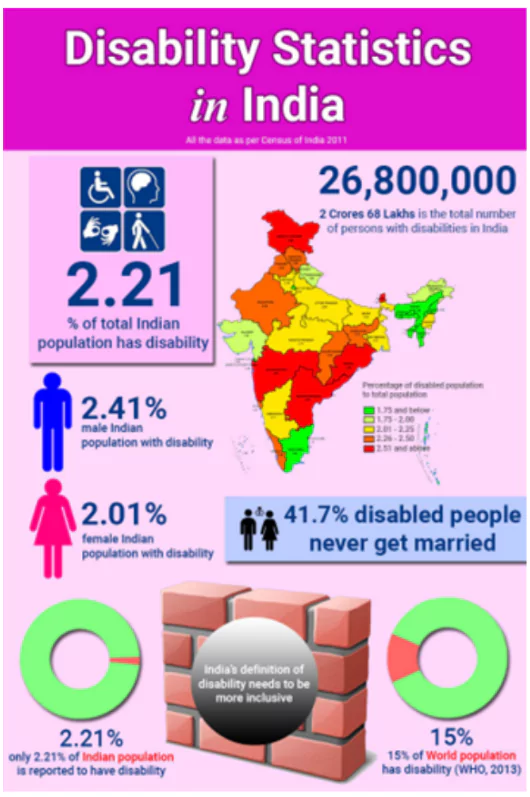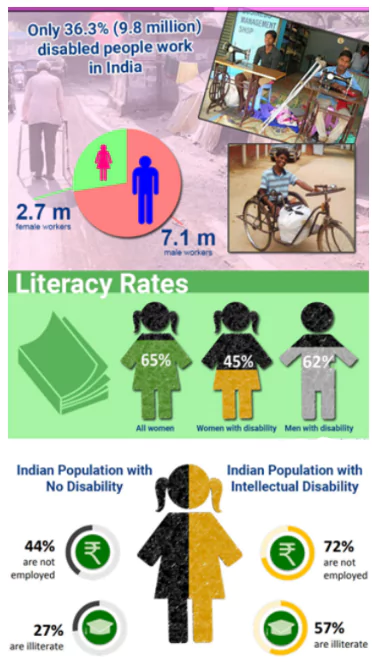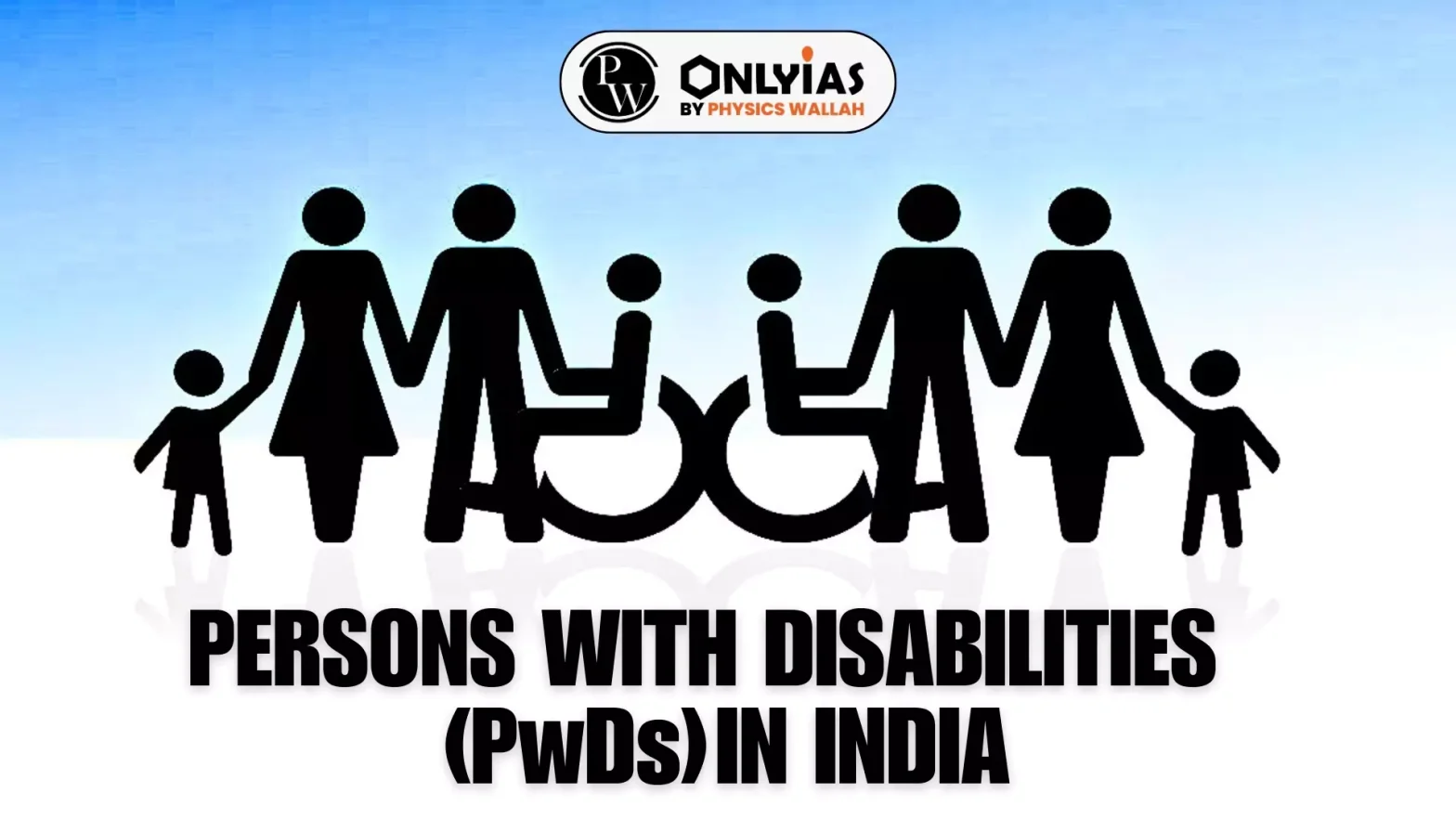Recently, the Supreme Court while hearing a plea to ban the film “Aankh Micholi” for derogatory portrayal of people with disabilities laid down comprehensive guidelines to prevent stereotyping and discrimination of persons with disabilities (PwDs) in visual media, including films and documentaries.
- The framework focuses on the prevention of stigmatisation and discrimination, recognising their profound impact on the dignity and identity of persons with disabilities.
About the Framework
Following are the seven points the bench expects filmmakers to adhere to, while representing people with disabilities in the visual media:
- On Discriminate Words: Call to avoid words which lead to institutional discrimination like words crippled, etc lead to negative self image and perpetuate discriminatory attitudes.
- On Language: Language that individualises the impairment and overlooks disabling social barriers, for example, words like “afflicted,” “suffering” and “victim”, should be avoided.
- Adequate Information: Creators must check for adequate medical info about an impairment like night blindness which may increase discrimination.
- Accurate Representation: It should not be based on myths, stereotypes show that impaired persons have enhanced sensory superpowers and that may not be for all.
- Stereotyping differently abled persons in visual media and films must end, asking creators to provide an accurate representation of disabilities rather than mocking them.
- Involvement: The court also asked creators to practise the principle of “nothing about us, without us,” and involve persons with disabilities in the creation and assessment of visual media content.
- Creative Freedom: It cannot include the freedom to lampoon, stereotype, misrepresent or disparage those already marginalised. In determining these aspects, the “intention” and “overall message” of the film have to be considered.
- Protection of Rights: Convention of rights to protect rights of PWD includes measures to portray them after consultation with their rights advocacy groups.
- Training and Sensitisation Programs: They should be implemented for individuals involved in creating visual media content, including writers, directors, producers, and actors.
Enroll now for UPSC Online Course
About Persons with Disabilities (PwDs) (Divyangjan)

Persons with disabilities have long term physical, mental, intellectual or sensory impairments which in interaction with various barriers may hinder their full and effective participation in society on an equal basis with others.
- Refers: Rights of Persons with Disabilities Act, 2016 defines “Person with Benchmark Disability” as “a person with not less than 40% of a specified disability”.
- Statistics: The 2011 census estimated that the number of people with disabilities in India is close to 2.68 crore (or 2.2% of the population) — that is more than the entire population of Australia.
- As per the National Statistics Office report 2021, about 2.2% of India’s population lives with some kind of physical or mental disability.
- Rural men had the highest prevalence of disability in India.
- According to the Indian Government, data on PwDs are largely taken from the decennial censuses and sample surveys on disability.
Models of Disability Rights
There are broadly two models under which disability rights are looked at, named medical and social models.
- Medical Model: It locates disability in the individual person. According to this model, disability is a medical deficit from a perceived normal.
- The goal is to cure the individual of their disability.
- Social Model: It locates disability within social spaces and systems. Society’s failure to support people with a variety of abilities creates barriers for, or disables, people.
- Society has a collective responsibility to create environments and social spaces that support full participation.
- Human Rights Model: It is a recent one, an evolution of the social model which says that people with disability are a part of society and have the same rights as everyone else.
- The Supreme Court’s emphasis on the human rights model is significant as it makes the government and private parties obliged to facilitate full and effective participation of persons with disabilities in society.
- Advantage: It places individuals in a sphere where all human rights principles which are applicable to anyone can be claimed by the disabled populace.
- Disadvantage: It is an abstract idea and difficult to implement.
Global Actions to Support PwDs
To support PwDs, following actions have been taken on a global level:
- Incheon Strategy: To “Make the Right Real” for Persons with Disabilities in Asia and the Pacific.
- United Nations Convention on Rights of Persons with Disability: To promote, protect and ensure the full and equal enjoyment of all human rights and fundamental freedoms by all persons with disabilities, and to promote respect for their inherent dignity.
- International Day of Persons with Disabilities: To promote the rights and well-being of persons with disabilities at every level of society and development, and to raise awareness of the situation of persons with disabilities in all aspects of political, social, economic, and cultural life.
- International Day of Persons with Disabilities (IDPD) is a UN day that is celebrated every year on 3 December.
Check Out UPSC CSE Books From PW Store
Constitutional Provisions to Support PwDs in India
Indian Government is under obligation to provide for better living conditions to Pwds in India under Indian Constitution. As per Article 21, no person shall be deprived of his life or personal liberty except according to the procedure established by law.
- Fundamental Rights: Dignity of the individual is the fundamental notion behind all the fundamental rights guaranteed under the Constitution.
- Directive Principles of State Policy: Article 41 states that the State should make effective provisions for securing the right to work, education and to public assistance in case of unemployment, old age, sickness and disability.
- As per Article 46, the State shall promote educational and economic interests of the weaker sections of the people and protect them from social injustice and all forms of exploitation.
- Seventh Schedule: Under it, relief of the Disabled is a State Subject (Entry 9 in List II).
- Eleventh and Twelfth Schedule: Welfare of the Disabled and mentally retarded is listed as item 26 in the Eleventh Schedule and item 09 in the Twelfth Schedule.
Initiatives taken by the Indian Government to Support PwDs
Following actions have been taken by the Indian Government to support, uplift and empower them:
- Mental Health Care Act (2017): To provide for mental healthcare and services for persons with mental illness and to protect, promote and fulfil the rights of such persons during delivery of mental healthcare and services and for matters connected therewith or incidental thereto.
- Rights of Persons with Disabilities Act, 2016: It is the disability legislation passed by the Indian Parliament to fulfil its obligation to the United Nations Convention on the Rights of Persons with Disabilities, which India ratified in 2007.
- National Trust Act (1999): It provides for the constitution of a body at the National level for the Welfare of Persons with Autism, Cerebral Palsy, Mental Retardation and Multiple Disabilities and for matters connected therewith or incidental thereto.
- The National Trust is a statutory body of the Ministry of Social Justice and Empowerment, Government of India.
- Rehabilitation Council of India Act (1992): It regulates training and registration of professionals working in the field of disability rehabilitation.
- Assistance to Disabled persons for purchasing / fitting of aids / appliances (ADIP) Scheme: To assist the needy disabled persons in procuring durable, sophisticated and scientifically manufactured, modern, standard aids and appliances that can promote their physical, social and psychological rehabilitation, by reducing the effects of disabilities and enhance their economic potential.
- Unique Disability ID, or UDID: To create a national database for persons with disabilities, “encourage transparency, efficiency and ease of delivering the government benefits” and for “stream-lining the tracking of physical and financial progress” of beneficiaries at all levels.
- Accessible India Campaign (Sugamya Bharat Abhiyan): To make public spaces, transportation, and information and communication technologies (ICT) accessible to PwDs.
- In the upcoming census, disability will be defined as per the Rights of Persons with Disabilities (or RPwD) Act of 2016.
- The Department of Disability Affairs is also in the process of creating a national database of PwDs, which will contain information on those with certificates issued by competent medical authorities.
- Others: PM-DAKSH (Divyang Skill Development and Rehabilitation Scheme), Deen-Dayal Disabled Rehabilitation Scheme, National Fellowship for Students with Disabilities, Indian Sign Language Research and Training Centre, etc.
Key Challenges Faced by PwDs in India
Despite various rights and legislation, they are facing various challenges which are mentioned below:

- Inadequate Infrastructure: Many public buildings, spaces, and transportation systems in India are not designed to be accessible. This includes lack of ramps, lifts, and accessible toilets.
- As per a 2018 report by the Department of Empowerment of Persons with Disabilities, only 3% of buildings in India were found to be fully accessible.
- Limited access to Information and Communication: Persons with visual and hearing impairments often face challenges in accessing information and communication due to the lack of Braille signage, sign language interpretation, and audio descriptions.
- Attitudinal Barriers: They often face discrimination and stigma due to negative attitudes and stereotypes held by society. Prejudice and misconceptions about disabilities contribute to the social marginalisation of people with disabilities.
- Stereotypes can hinder their opportunities for education, employment, and social integration, perpetuating a cycle of exclusion and isolation.
- Educational Barriers: Despite legislative efforts to promote inclusive education, barriers persist within educational institutions.
- Inaccessible facilities, a lack of appropriate accommodations, and a shortage of trained educators contribute to the academic challenges faced by students with disabilities.
- About 45% of disabled people are illiterate, and only 62.9% of disabled people aged 3 to 35 have ever attended regular schools.
- Employment Disparities: The job market can be particularly challenging for individuals with disabilities. Discrimination, inaccessible workplaces, and lack of accommodations often limit their employment opportunities.
- India has almost 3 crore PwD of which around 1.3 crore is employable but only 34 lakh of them have been employed.
- Healthcare Disparities: Access to quality healthcare can be compromised for people with disabilities. Barriers may include physical inaccessibility of healthcare facilities, lack of accessible information, and the neglect of specific healthcare needs.
- Financial Strains: Living with a disability can incur additional costs, such as medical expenses, assistive devices, and specialised care.
- Technological Gaps: While technology has the potential to empower individuals with disabilities, there is a significant gap in access.
- Not all assistive technologies are affordable or readily available, limiting the ability of people with disabilities to leverage the full range of technological advancements.
- Access to assistive technology, such as hearing aids and mobility aids, is limited in India, making it difficult for Divyangjans to perform daily tasks.
- In India, a study found that only 29% of people with disabilities own assistive devices, while 71% have unmet needs (Karki et al., 2021).
- Others: Public transportation systems are often not designed with the needs of individuals with disabilities in mind.
- The emotional toll of living with a disability should not be underestimated. Individuals may face higher rates of depression, anxiety, and social isolation.
- Digital Divide: With a rapid rise in digitalization, many PwDs are being left behind due to inaccessible digital platforms and technologies. This digital divide exacerbates existing inequalities in education, employment, and social participation.
- According to a 2020 report by the 2020 Web Accessibility Annual Report, 98% of websites fail to comply with accessibility requirements for PwD.
- Legal and Policy Implementation Gap: While India has progressive laws like the Rights of Persons with Disabilities Act, 2016, implementation remains a major challenge. Many provisions remain on paper, creating a “paper tiger” syndrome.
Enroll now for UPSC Online Classes
Way Forward
India needs to address the various aforementioned challenges faced by PwDs to empower them and harness their skills for the growth and development of India.
- Implementing and Enforcing the Existing Laws and Policies: It protects the rights and interests of persons with disabilities, such as the Rights of Persons with Disabilities Act, 2016 and the Draft National Policy for Persons with Disabilities, 2022.
- Change Perceptions about PwDs: There is a need to shift societal attitudes by promoting the use of empowering terms such as “Divyang” instead of “Viklang” (disabled).
- Highlight the abilities and achievements of PwDs through media, arts, and public platforms to foster a more inclusive and respectful society.
- The recent framework for visual media, can have been sent by the SC to all departments for sensitisation.
- Inclusive Digital Governance Platforms: There is a need to redesign e-governance platforms with a focus on universal accessibility. It would involve creating multimodal interfaces (voice, text, video) for all government services, ensuring compatibility with various assistive technologies, and providing real-time sign language interpretation for video-based services.
- Promotion of Inclusive Education: For children with disabilities in regular schools, and providing them with adequate support, resources, and training. This can help them develop their potential and skills, and integrate them into the society.
- Enhancement of the Accessibility: Forphysical environment, transportation, information and communication, technology and services for persons with disabilities, and removing any barriers or obstacles that hinder their participation and inclusion.
- Increasing the Opportunities and Incentives: For vocational training, skill development, self-employment, and formal employment for persons with disabilities, and ensuring non-discrimination and equal pay in the labour market.
- Providing Social Security Benefits: Such as healthcare services, insurance schemes, rehabilitation programs, and other welfare measures for persons with disabilities, and ensuring their affordability and quality.
- Raising Awareness and Sensitisation: It should be done among the public, media, government, civil society, and private sector about the rights, needs, abilities, and contributions of persons with disabilities, and challenging the negative stereotypes and stigma associated with disability.
- Others:
- Encouraging the Participation and Representation: In decision-making processes at all levels, and ensuring their voice and choice in matters affecting them.
- Support Research and Innovation: In the field of disability, and promoting the dissemination and exchange of best practices and knowledge on disability inclusion.
- Collaborating with State governments: Using data from surveys they are conducting, consulting experts, and sensitising surveyors of the Ministry of Statistics.
![]() 16 Jul 2024
16 Jul 2024



